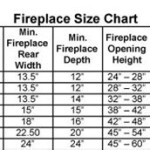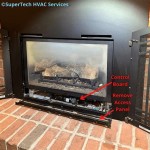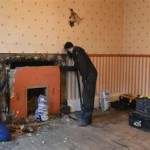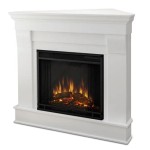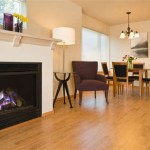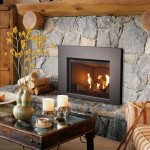Black Gas Fireplace Paint: Enhancing Aesthetics and Durability
Black gas fireplace paint is a specialized coating designed to withstand the high temperatures generated by gas fireplaces. This paint serves both an aesthetic and functional purpose, revitalizing the appearance of the fireplace while offering protection against rust, corrosion, and wear. Understanding the properties, selection criteria, and application methods of black gas fireplace paint is crucial for homeowners seeking to enhance the beauty and longevity of their fireplace.
The high-heat resistance is a critical characteristic of this specialized paint. Regular paints would blister, peel, and potentially emit harmful fumes when exposed to the intense heat produced by a gas fireplace. Black gas fireplace paint is formulated with specific resins and pigments that maintain their integrity and color even at temperatures exceeding 1200 degrees Fahrenheit, depending on the specific product. This heat resistance ensures the paint remains intact and protects the underlying metal from damage caused by prolonged exposure to high temperatures. The color black also contributes to heat absorption and even distribution, maximizing the fireplace's efficiency.
Beyond aesthetics and temperature tolerance, black gas fireplace paint often incorporates rust inhibitors and corrosion-resistant compounds. The interior components of a fireplace, such as the firebox and burner assembly, are susceptible to rust due to the presence of moisture and combustion byproducts. Rust can weaken these components over time, potentially compromising the fireplace's structural integrity and functionality. The protective layer provided by the paint acts as a barrier, shielding the metal from corrosive elements and extending the lifespan of the fireplace. This is particularly important in areas with high humidity or where the fireplace is used frequently.
The selection of the appropriate black gas fireplace paint involves several considerations, including the type of metal being painted, the maximum operating temperature of the fireplace, and the desired finish (matte, satin, or gloss). Proper surface preparation is equally vital for ensuring optimal adhesion and a long-lasting finish. This typically involves cleaning the surface to remove dirt, grease, and rust, followed by light sanding to create a slightly rough texture that promotes paint bonding. Application techniques, such as using multiple thin coats, also play a significant role in achieving a professional-looking and durable result.
Key Point 1: Understanding the Composition and Properties of High-Heat Paint
High-heat paints, including those specifically formulated for gas fireplaces, differ significantly from standard paints in their chemical composition. They rely on a combination of heat-resistant resins, pigments, and additives that enable them to withstand extreme temperatures without degrading. Common resins used in these paints include silicone, epoxy, and phenolic resins, each offering varying levels of heat resistance and durability. Silicone resins, for example, are known for their excellent heat stability and are often used in paints designed for the highest temperature applications.
The pigments used in black gas fireplace paint are carefully selected for their ability to retain their color and integrity under high heat. Regular pigments can fade, discolor, or even break down at elevated temperatures, resulting in an unsightly appearance. Heat-stable pigments, such as iron oxides and carbon black, are commonly used to provide the desired black color and maintain its vibrancy even after prolonged exposure to the fireplace's heat. The concentration and type of pigment also influence the paint's heat absorption and emissivity properties, which can affect the fireplace's overall performance.
Additives play a crucial role in enhancing the paint's performance characteristics. Rust inhibitors are often incorporated to protect the metal surface from corrosion, while flow modifiers improve the paint's application properties, ensuring a smooth and even finish. Other additives may be included to enhance the paint's scratch resistance, UV resistance, or chemical resistance, depending on the specific requirements of the application. Understanding the specific components of the paint and their respective functions is essential for selecting the right product for the intended use.
The heat resistance of black gas fireplace paint is typically expressed as a maximum continuous operating temperature. This value indicates the highest temperature the paint can withstand for extended periods without significant degradation. It is crucial to select a paint with a heat resistance rating that exceeds the maximum operating temperature of the fireplace to ensure the paint's long-term durability. Exceeding the paint's heat resistance limit can lead to blistering, peeling, cracking, and the release of harmful fumes.
Key Point 2: Ensuring Proper Surface Preparation for Optimal Adhesion
Surface preparation is a critical step in the painting process that significantly impacts the adhesion and longevity of the paint finish. Inadequate surface preparation can lead to premature paint failure, even when using high-quality black gas fireplace paint. The surface must be clean, dry, and free of any contaminants that could interfere with the paint's ability to bond to the metal. This typically involves a multi-step cleaning and preparation process.
The first step in surface preparation is to remove any loose debris, dirt, grease, or rust from the surface. This can be accomplished by using a wire brush, scraper, or sandpaper to remove loose particles. For heavy rust or corrosion, a chemical rust remover may be necessary. It's important to follow the manufacturer's instructions carefully when using chemical rust removers, as they can be corrosive and require proper ventilation and protective gear. After removing loose debris and rust, the surface should be thoroughly cleaned with a degreasing cleaner to remove any oil, grease, or other contaminants.
After cleaning the surface, it's essential to create a slightly rough texture to promote paint adhesion. This can be achieved by lightly sanding the surface with fine-grit sandpaper. Sanding not only creates a mechanical bond for the paint but also helps to remove any remaining surface imperfections. The sandpaper should be applied evenly to avoid creating deep scratches or uneven surfaces. After sanding, the surface should be wiped down with a tack cloth to remove any sanding dust.
In some cases, a primer may be necessary to improve paint adhesion and provide additional protection against rust and corrosion. A high-heat primer specifically designed for metal surfaces is recommended for gas fireplace applications. The primer should be applied in thin, even coats, following the manufacturer's instructions. Allow the primer to dry completely before applying the black gas fireplace paint. Priming is especially beneficial when painting over bare metal or surfaces that have been heavily rusted.
Key Point 3: Application Techniques for a Durable and Professional Finish
The application technique used to apply black gas fireplace paint plays a significant role in the final appearance and durability of the finish. Proper application techniques can ensure a smooth, even coating that adheres well to the surface and provides long-lasting protection. Conversely, incorrect application techniques can lead to runs, drips, uneven coverage, and premature paint failure. Selecting the appropriate application method and following recommended guidelines are crucial for achieving optimal results.
Black gas fireplace paint can be applied using various methods, including aerosol spray cans, brushes, and spray guns. Aerosol spray cans are a convenient option for small projects and touch-ups, while brushes and spray guns are better suited for larger areas and more complex shapes. When using an aerosol spray can, it's important to shake the can thoroughly before use and hold it approximately 10-12 inches away from the surface. Apply the paint in thin, even coats, overlapping each pass slightly to ensure complete coverage. Avoid applying thick coats, as this can lead to runs and drips.
When using a brush to apply black gas fireplace paint, select a high-quality brush with synthetic bristles. Natural bristles can melt or become damaged when exposed to high temperatures. Dip the brush into the paint and apply it to the surface in smooth, even strokes. Avoid applying too much paint at once, as this can lead to brush marks and uneven coverage. Work in small sections and overlap each stroke to ensure a seamless finish. Clean the brush thoroughly with the appropriate solvent after each use.
Spray guns provide the most uniform and professional-looking finish but require more skill and equipment. When using a spray gun, thin the paint according to the manufacturer's instructions. Adjust the spray gun settings to achieve the desired spray pattern and flow rate. Apply the paint in thin, even coats, overlapping each pass slightly. Maintain a consistent distance and angle from the surface to ensure even coverage. Wear appropriate respiratory protection when spraying paint, as the fumes can be harmful.
Regardless of the application method used, it's essential to apply multiple thin coats of black gas fireplace paint rather than one thick coat. Thin coats dry more quickly, adhere better to the surface, and are less prone to runs and drips. Allow each coat to dry completely before applying the next coat, following the manufacturer's recommended drying time. Typically, two to three thin coats of paint are sufficient to achieve full coverage and a durable finish.
After applying the final coat of paint, allow it to cure completely before using the gas fireplace. Curing time varies depending on the specific paint product and environmental conditions, but it typically takes several days to a week for the paint to fully harden and reach its maximum heat resistance. Avoid exposing the painted surface to moisture or extreme temperatures during the curing process.

Gorgeous Diy Fireplace Makeover 3 Reasons To Paint Your Black Lehman Lane

Fireplace Makeover Spray Paint Magic

How To Spray Paint Fireplace Interior The Diy Playbook

30 Gorgeous Painted Brick Fireplace Ideas

Expert Tip Paint The Fireplace Black

How To Paint The Inside Of A Fireplace Simple Upgrade Maria Louise Design

Fireplace Makeover Spray Paint Magic

We Painted Our Stone Fireplace Black Most Lovely Things

Fireplace Makeover Spray Paint Magic

Fireplace Makeover Spray Paint Magic
Related Posts


